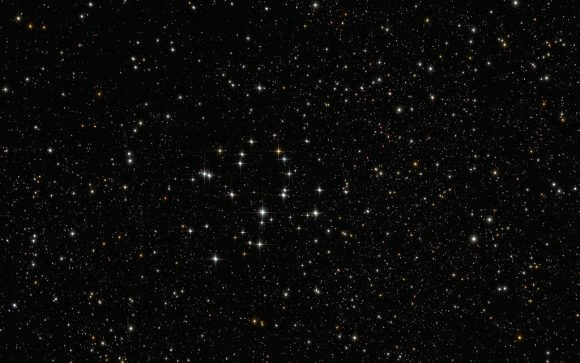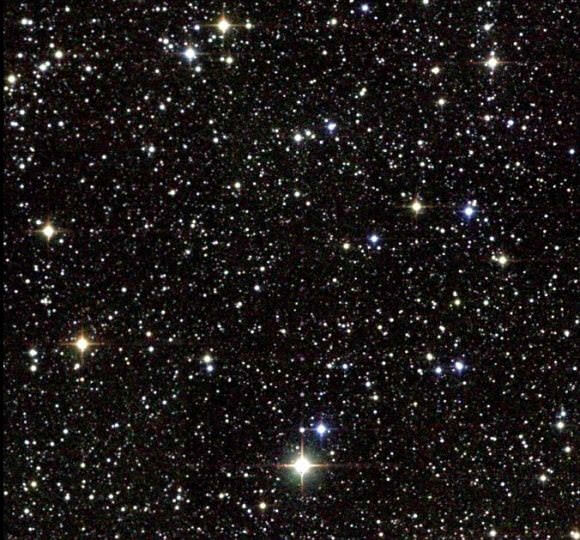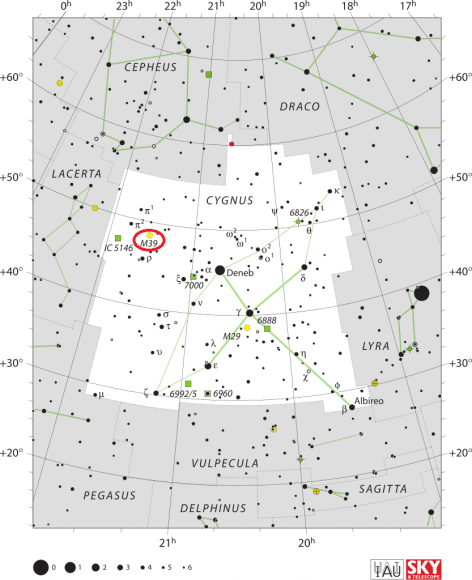Welcome back to Messier Monday! In our ongoing tribute to the great Tammy Plotner, we take a look at the open galactic star cluster known as Messier 39. Enjoy!
During the 18th century, famed French astronomer Charles Messier noted the presence of several "nebulous objects" in the night sky. Having originally mistaken them for comets, he began compiling a list of them so that others would not make the same mistake he did. In time, this list (known as the Messier Catalog) would come to include 100 of the most fabulous objects in the night sky.
One of these objects is known as Messier 39, an open star cluster located in the direction of the Cygnus constellation. Because of its proximity to Deneb and its size - it is actually larger in the night sky than a full Moon - it is easily observed using binoculars and small, low magnification telescopes.
Description:
Positioned only about 800 light years away from our solar system, this 300 million year old group of about 30 stars may look like they are spread fairly far apart in the sky. But as clusters go, they are close, really close! This group is gathered in space in only a 7 light year neighborhood! All of its stars are main sequence and the very brightest of them are just about to evolve into the red giant star phase.
In a study done by Jean Claude Mermilliod (et al), they conducted a long-term monitoring of solar-type dwarfs with CORAVEL - a study which took 19 years. While most individual radial velocities were never published - apart from a small number of spectroscopic binaries - the stars themselves and their properties were well documented in the works of B. Uyaniker and T. L. Landecker of the National Research Council, Herzberg Institute of Astrophysics.

Low-magnification image of Messier 39. Credit: Christian van Endern
As Uyaniker and Landecker claimed in their 2002 study, "A Highly Ordered Faraday-Rotation Structure in the Interstellar Medium":
"We describe a Faraday rotation structure in the interstellar medium detected through polarimetric imaging at 1420 MHz from the Canadian Galactic Plane Survey (CGPS). The structure, at l = 918,b = -25, has an extent of ~2°, within which polarization angle varies smoothly over a range of ~100°. Polarized intensity also varies smoothly, showing a central peak within an outer shell. This region is in sharp contrast to its surroundings, where low-level chaotic polarization structure occurs on arcminute scales. The Faraday rotation structure has no counterpart in radio total intensity and is unrelated to known objects along the line of sight, which include a Lynds Bright Nebula, LBN 416, and the star cluster M39 (NGC 7092). It is interpreted as a smooth enhancement of electron density. The absence of a counterpart, in either optical emission or total intensity, establishes a lower limit to its distance. An upper limit is determined by the strong beam depolarization in this direction. At a probable distance of 350 ± 50 pc, the size of the object is 10 pc, the enhancement of electron density is 1.7 cm-3, and the mass of ionized gas is 23 M. It has a very smooth internal magnetic field of strength 3 UG, slightly enhanced above the ambient field. G91.8-2.5 is the second such object to be discovered in the CGPS, and it seems likely that such structures are common in the magneto-ionic medium."
So where do these gases come from? Perhaps they are there all along. As Yu N. Efremov and T.G. Sitnik wrote in their 1988 study:
"It is found that about 90% of young clusters o-b2 and OB-associations situated within 3 kpc from the Sun are united into complexes with diameters from 150 to 700 pc. Almost all complexes contain giant molecular clouds with masses. A number of complexes (mostly large ones)-are connected with giant H I clouds; a few of small complexes are situated in the H I-caverns. Older (>b2) cluster avoid the regions occupied by young star groups. Complexes often have an hierarchic structure; some neighbouring complexes may be united into supercomplexes with diameters about 1.5 kpc."
Does this mean it's possible that M39 could be more than one cluster combined? As H. Schneider wrote in his 1987 study:
"Early-type stars up to 12.0 mag and spectral type F2 in two young northern clusters were investigated by means of Stromgren and H-beta photometry. The distance and reddening of the clusters were estimated, and the membership of the stars discussed. In the case of NGC 7039 a distance of 675 pc and a color excess of E(b-y) = 0.056 were found; the respective values for NGC 7063 were 635 pc and E(b-y) = 0.062. The reality of NGC 7039 is somewhat puzzling: it seems that there exists a loose star aggregate called NGC 7039, containing about six to nine stars, and in the background another cluster at a distance of about 1500 pc. Besides this, variable reddening across the cluster area is probable."

Atlas Image mosaic of Messier 39, obtained as part of the Two Micron All Sky Survey (2MASS). Credit: NASA/NSF/IPAC/Caltech/Univ. of Mass.
History of Observation:
While it is possible this bright star cluster was remarked upon by Aristotle as a cometary appearing object about 325 BC, and it is also possible that it may have been discovered by Le Gentil in 1750, the fact remains M39 is most frequently attributed to be an original discovery of Charles Messier. As he recorded in his notes:
"In the night of October 24 to 25, 1764, I observed a cluster of stars near the tail of Cygnus: One distinguishes them with an ordinary (nonachromatic) refractor of 3 and a half feet; they don't contain any nebulosity; its extension can occupy a degree of arc. I have compared it with the star Alpha Cygni, and I have found its position in right ascension of 320d 57' 10", and its declination of 47d 25' 0" north."
Because Sir William Herschel did not publish his findings on Messier's works, very few have read his observations of the object -"Consists of such large and straggling stars that I could not tell where it began nor where it ended. It cannot be called a cluster." However, it would later go on to receive a New General Catalog (NGC) designation by Sir John Herschel who would describe it as "A star of 7th mag [position taken], one of a large loose cluster of stars of 7th to 10th magnitude; very coarsely scattered, and filling many fields."
Even as accomplished as historic observers were, they sometimes didn't always do the right thing. In the case of Messier 39, it is so close to us that it appears large dimensionally in the sky - and therefore needs less magnification instead of more to be properly studied as a whole. However, don't always put away the magnfication, because as Admiral Smyth reports:
"A loose cluster, or rather splashy galaxy field of stars, in a very rich visinity between the Swan's tail and the Lizard, due south of Beta Cephei, and east-north-east of Deneb [Alpha Cygni]. This was picked up by Messier in 1764, with his 3 1/2 foot telescope, and registered as being a degree in diameter. Among them there are several pairs, of which a couple were slightly estimated; the first being the brightest star (7m) and its comes, and the second a pretty pair of 10th-magnitudes."

The location of Messier 39 in the Cygnus constellation. Credit: IAU/Sky & Telescope magazine/Roger Sinnott & Rick Fienberg)
Locating Messier 39:
This coarse open star cluster is easily found in small optics. Start first by identifying the very large constellation of Cygnus and pinpointing its brightest, northernmost star. Aim you binoculars there. You'll find M39 about 9 degrees east and a bit north of Deneb (Alpha Cygni). If at first you don't succeed, try looking at Deneb from a dark sky location and see if you can spot a small, hazy patch about a fist width away to the east. There's your star cluster!
It will also show easily in the telescope finderscope as a hazy patch and even begin resolution with larger aperture finders. M39 is very well suited to light polluted skies and moonlit observing and will even hold up well to less than ideal sky conditions. Small instruments will easily see a bright handful of stars while larger telescopes will resolve many more faint members and pairs. Because of its large apparent size, you'll enjoy viewing M39 far more if you use the least amount of magnification possible.
Enjoy this star-studded cluster and the great Milky Way field that frames it!
And here are the quick facts on this Messier Object to help get you started:
Object Name: Messier 39
Alternative Designations: M39, NGC 7092
Object Type: Galactic Open Star Cluster
Constellation: Cygnus
Right Ascension: 21 : 32.2 (h:m)
Declination: +48 : 26 (deg:m)
Distance: 0.825 (kly)
Visual Brightness: 4.6 (mag)
Apparent Dimension: 32.0 (arc min)
We have written many interesting articles about Messier Objects here at Universe Today. Here's Tammy Plotner's Introduction to the Messier Objects, , M1 – The Crab Nebula, M8 – The Lagoon Nebula, and David Dickison's articles on the 2013 and 2014 Messier Marathons.
Be to sure to check out our complete Messier Catalog. And for more information, check out the SEDS Messier Database.
Sources:
No comments:
Post a Comment